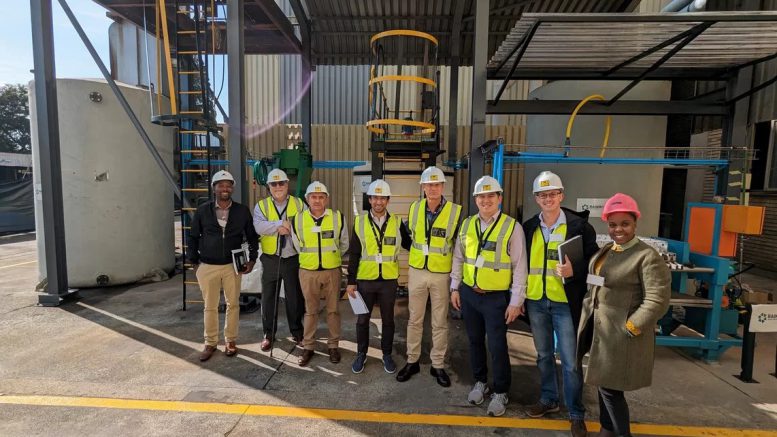Rainbow Rare Earths (LSE: RBW) is making strides in the rare earths sector as its Phalaborwa project in South Africa underpins an aggressive international growth strategy.
While pilot-scale production at Phalaborwa started in June, the London-based miner recently signed a memorandum of understanding (MoU) with U.S. major The Mosaic Company (NYSE: MOS) to collaborate on a rare earths project in Minas Gerais state, Brazil.
“Phalaborwa’s rapid progress as a near-term producer of magnet rare earths showcases our dedication to delivering on our promises and de-risking the project, making it a cornerstone of our strategic growth,” CEO George Bennet tells The Northern Miner in an interview Wednesday.
The company will ultimately use a technologically innovative approach to produce high-purity separated magnetic rare earth oxides such as neodymium, praseodymium, terbium, and dysprosium from waste phosphogypsum stacks.
In South Africa, the Phalaborwa project is divided into two main phases: the front-end and the back-end pilot plant operations. In the front-end phase, material from the historic gypsum stacks found at the sleepy Limpopo province town of Phalaborwa is processed through a series of steps, including gypsum washing, acid leaching, fluoride removal via continuous ion exchange (CIX), rare earth precipitation, and a sulphuric acid agitated bake (SAAB). This process results in the production of an intermediate-value mixed rare earth sulphate.

Rainbow Rare Earths CEO George Bennett. Credit: Rainbow Rare Earths
The front-end process, done at the Council for Mineral Technology (Mintek) facilities in Johannesburg, South Africa, aims to consolidate the rare earths into a concentrated form before further processing. The mixed rare earth sulphate produced here is then shipped to Rainbow’s partner company’s K-Technologies’ (K-Tech) rare earth separation plant in Lakeland, Fla., for further refinement.
In the back-end phase, the mixed rare earth sulphate goes through a hydrometallurgical process involving CIX and continuous ion chromatography at the K-Tech plant. This process allows for the separation and purification of individual, high-purity rare earth oxides, which are suitable for direct use in various industries.
Output from the K-Tech facility will make Rainbow the only producer of separated magnetic rare earth oxides in the U.S. and the sole producer of dysprosium and terbium oxides outside Asia. The pilot plant operations are a critical step in demonstrating the feasibility of the process, de-risking the project, and showcasing Rainbow’s unique position in the rare earth supply chain, said Bennett.
Growth platform
An October 2022 PEA calculated strong base economics. The Phalaborwa project will produce 26,208 tonnes of separated magnetic rare earth oxides over 14.2 years.
The project’s financial health looks good, with a net present value (10% discount) of US$627 million after taking out taxes, and it could make a profit of 40%.
Rainbow will spend about US$295.5 million to set up the project, but they will recoup that money in about two years.
If the prices of the unique materials go up, they could make even more money.
It should cost Rainbow around US$33.86 to make one kilogram of rare earths, and Bennett says the project has one of the highest-paying baskets of any rare earths project under development.
“We expect to receive the highest basket price of any project, excluding China, at US$175.89 per kilogram,” said Bennett.
A March resource update estimates Phalaborwa to host a Joint Ore Reserves Committee-compliant resource of 30.4 million tonnes grading 0.44% total rare earths oxides (TREO). According to Bennett, the high-value magnet rare earths neodymium and praseodymium represent 29% of the TREO, with economic quantities of terbium and dysprosium.
The company will undertake additional drilling to upgrade the resource as part of a forthcoming feasibility study early in 2024, underpinning the company’s project financing endeavours and construction for the earliest potential for commercial production to start in 2026.
The successful production of separated rare earth oxides from the mixed rare earth sulphate validates Rainbow’s ability to contribute to producing sustainable and essential materials for the green energy transition. This project highlights Rainbow’s technological expertise and its commitment to environmental sustainability and responsible resource utilization.
The next steps at Phalaborwa entail publishing a resource update and defining the parameters for a feasibility study, which could provide further insights into the project’s potential.

The March 2023 Phalaborwa resource estimate. Credit: Rainbow Rare Earths
Brazil opportunity beckons
On July 17, Rainbow announced it had signed an MoU with Mosaic, an Americas-focused producer of concentrated phosphate and potash. The collaboration aims to jointly develop a process flowsheet and conduct a PEA to extract rare earth elements (REE) from Mosaic’s phosphogypsum stack in the Uberaba area of Minas Gerais, Brazil.
Like Phalaborwa, the Uberaba phosphogypsum stack contains valuable REE as by-products of phosphoric acid production. Rainbow intends to leverage its exclusive technology to extract these REEs from the Uberaba stack.
It has not yet disclosed a resource estimate for the Uberaba project.
This collaboration with Mosaic represents an opportunity for Rainbow to expand its portfolio and become a multi-asset producer of REE from secondary sources. According to Bennett, the geographic diversification aligns with Rainbow’s strategic goal of establishing an independent and ethical supply chain of REE for the green energy transition.
“With our focus on projects like Phalaborwa and our pioneering proprietary technologies, we are not only redefining the rare earth industry but also contributing to a greener future. Our recent partnerships and achievements are a testament to our vision, and we remain steadfast in our journey to lead the way in responsible resource management and ethical supply chains,” said Bennett.
Sustainability is a cornerstone of Rainbow’s approach, evident in its plans for environmental reclamation at the Phalaborwa site. The transformation of historic phosphogypsum stacks into benign gypsum stacks underscores the company’s commitment to responsible resource management and environmental stewardship.
Rainbow last traded in London at 13.25p ($22.49) per share, up more than 15% in the past 12 months after touching 7.02p and 15.50p, for a market capitalization of £79. 5 million ($135 million).


Be the first to comment on "How Rainbow Rare Earths plans to bootstrap itself onto the global stage"